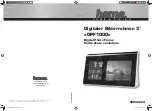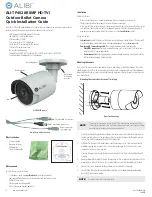
4. Setting Aperture
Manual aperture controls enable you to select the size of your lens
diaphragm opening, across the possible f-stops of f/2.8 (greatest
possible aperture), f/4, f/5.8, f/8, f/11, and f/16 (smallest
possible aperture). The greater the aperture, the more light is
admitted through the lens. The smaller the aperture, the greater
the possible depth of field (total amount of your image in focus).
Select your aperture by turning the outmost ring of the lens (8).
Example A
Your exterior light is low. Choosing a large aperture (f/2.8 or
f/4) allows for a shorter required shutter time for proper exposure,
thereby lessening the chance of camera shake or image blurring
Example B
You require both your foreground and background to be in focus.
Choose a small aperture (f/16) to maximize “depth of field,”
allowing the lens and film to render the majority of the image in
correct focus
Example C
You would like to create a portrait.
Choose a large aperture
(f/2.8) to render your close foreground in focus, imposed against a
very blurred background.
Alternately, choose a medium aperture
(f/5.6) on a subject at medium focal distance, highlighting it in
focus between a slightly out-of-focus foreground and a very out-of-
focus background.
5. Setting Exposure
Taking correct exposures and setting the shutter speed properly with
the Fed 5 is an acquired skill. To do it three elements must be
considered.
* ASA Film speed – anywhere from ASA 25 to ASA 400. Higher film
speeds allow for faster exposures, and therefore need less light to
expose properly.
* Aperture – from f-stop 2.8 to 16. Lower aperture numbers yield a
wider “iris” opening for the lens, allowing more light in and
faster exposures.
* External Light – the more light, the faster the exposure can be.
Your light settings are provided courtesy of the Selenium match
needle. This works without batteries , and should keep functioning
for another 25 years or so to come.
First, take a look at your exposure wheel, on the left top of the
camera.
This is your guide to excellent Fed 5 images.
The
innermost guide ring (17) corresponds with the ASA speed of your
film. Line up the appropriate green number (from a choice of 25
through 400) with the small vertical black line on the silver metal
inner ring. Next, point the camera towards the subject you want to
photograph. The match needle (7) will assess the exterior light and
give you a value between 1 (darkest) and 11 (brightest).
The
outermost ring (18) of your exposure wheel has a small window, with
numbers inside. Rotate the ring until the window number corresponds
with the match needle reading.
























